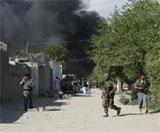
Kabul, April 15: Heavily-armed Taliban suicide bombers today unleashed a wave of coordinated attacks in Afghanistan with several explosions and gunfire rocking the diplomatic area and Parliament in Kabul and three other cities but no Indian target was attacked.
According to India's ambassador to Afghanistan Gautam Mukhopadhyay, all Indians were safe.
ITBP director general Ranjit Sinha said there was no threat to the Indian embassy as it was located three to four km away from the scene of the attack this afternoon by the Taliban gunmen who came from different directions in perhaps an unprecedented assault of this nature.
Taliban claimed responsibility for around a dozen attacks by the gunmen in central Kabul which has stunned Afghan authorities. Any casualties is still unknown but Kabul police chief Mohammad Ayoubi Salangi was quoted as having said one attacker had been killed near the Parliament.
The militants attacked five-star Kabul Star Hotel in Wazir Akhbar Khan area of the capital and some tried to enter the Afghan parliament firing rockets but were engaged by security forces and driven back, officials said.
An unknown number of Taliban men armed with light and heavy weapons targeted Afghan governmental and International offices in three different areas of Kabul, police said.
A number of Taliban militants took positions at a newly-build building at the Shahr-e-Naw, a neighborhood of Kabul. They battled with Afghan forces for several hours after the militants began assaulting Western embassies.
The building is located close to American embassy, Turkey embassy, presidential palace, Iranian embassy, ISAF's headquarters, German embassy, UK embassy and different other diplomatic offices.
"I am on the spot and hearing the gunfire being traded between the suicide bombers and Afghan forces. Until now I heard several explosions," a PTI correspondent reported from the scene of attack.
In a text message to the reporters, Taliban spokesman Zabihullah Mujahed said: "Today, afternoon, at 1 pm, suicide bombings are happening by our Mujaheddeen at the ISAF headquarters, Parliament building, and other diplomatic offices in Kabul, and our enemies got many casualties."
The militants also struck at an airport in Jalalabad, Logar and Paktia.
A few others Taliban militants armed with heavy weapons positioned at a newly-build building are targeting Afghan parliament at the Darul Aman area of Kabul. The battle is ongoing between Afghan and Taliban militant forces, Afghan private tv, Tolo Tv, said today.
Another group of militants are targeting an ISAF's base, Turkish military base, and a training camp of Afghan national army at Pule Charkhi area of Kabul. They are targeting them from a building which they took under their control.
According to the eyewitness, suicide bombers had taken over the newly-built five-star hotel in Kabul, which was reportedly on fire.
Outside Kabul, two suicide bombers blew themselves up at the gates to Jalalabad airport in eastern city of Nangarhar province, wounding several people, police said.
Four bombers tried to enter the airport and two detonated their explosives when they were stopped at the gate, officials said. Two others were wounded and arrested.
Taliban militants also attacked ISAF's Provincial Reconstruction Team, Or PRT, in Jalalabad. "The battle is going on," Tolo tv said.
"In Jalalabad, several mujahidin attacked airport and PRT compound. The fighting is going on and our mujahidin are showing very strong resistance," the Taliban spokesman said.
According to reports, Taliban also attacked military academy compound in Jalalabad road, District No 9 of Kabul.
In Logar province, Taliban militants attacked a police compound, PRT compound and provincial intelligence department.
In Paktia province also, Taliban attacked police regional zone compound, airport, police headquarters and intelligence department. "The fighting is going on in all the provinces," Mujahed said.
"Our mujahidin are equipped with small and heavy weapons and also suicide vests," Mujahed said, adding "this attack was planned very well."
"Mujahidin attacked Afghanistan parliament compound and still the fighting is going on and we don't have casualties reports until now," the Taliban spokesman said.
The attackers also fired rockets at the parliament building and at the Russian embassy, officials said.
The embassies were not immediately available to comment.





Comments
Add new comment